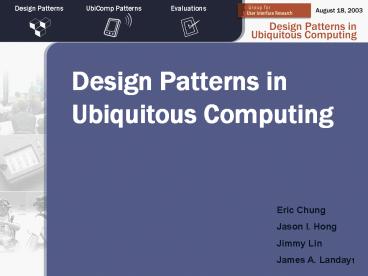Design Patterns in Ubiquitous Computing PowerPoint PPT Presentation
Title: Design Patterns in Ubiquitous Computing
1
Design Patterns
UbiComp Patterns
Evaluations
Design Patterns in Ubiquitous Computing
Eric Chung Jason I. Hong Jimmy Lin James A. Landay
2
Introduction to Design Patterns
Design Patterns
UbiComp Patterns
Evaluations
- Patterns are developed to communicate common
problems and solutions for designers in a
discipline - First introduced by Christopher Alexander and his
colleagues in the field of architecture
3
Beer Hall Example
Design Patterns
UbiComp Patterns
Evaluations
- Problem
- Where can peoplesing and drink, andshout and
drink,and let go of their sorrows? - Solution
- Somewhere in the community at least one big place
where a few hundred people can gather, with beer
and wine, music, and perhaps a half-dozen
activities, so that people are continuously
crisscrossing from one to another.
4
Design Patterns for Ubiquitous Computing
Design Patterns
UbiComp Patterns
Evaluations
- Help designers create higher-quality designs
faster by developing a pattern language for
UbiComp - Difficult to identify patterns because many
design issues are still active areas of research - Difficult because certain problems do not have
common solutions (have to resort to predictive
patterns rather than descriptive)
5
Identifying Patterns
Design Patterns
UbiComp Patterns
Evaluations
- We developed a criteria for identifying patterns
- Pattern should have at least one example in
research and one example in industry - A list of over 60 UbiComp patterns have been
identified - Patterns are grouped into several important
UbiComp themes (e.g., privacy) - A taxonomy of UbiComp applications is also
important to consider
6
Chart of UbiComp Patterns
Design Patterns
UbiComp Patterns
Evaluations
7
Chart of UbiComp Patterns
Design Patterns
UbiComp Patterns
Evaluations
8
Applying Patterns
Design Patterns
UbiComp Patterns
Evaluations
- Exercise Apply patterns to In/Out Board
9
Applying Patterns
Design Patterns
UbiComp Patterns
Evaluations
- Exercise Apply patterns to In/Out Board
- Identify some relevant themes and their patterns
- Privacy Appropriate Scope of Locality, Partial
Identification (might only show first names),
Choice, Access, Appropriate Retention Time - Identification Active Badge, Smart Floor
- Global Data Active Map
10
Evaluating the Patterns
Design Patterns
UbiComp Patterns
Evaluations
- Perform an experiment
- Conditions create two groups, one with patterns,
one without - Task 1 ask the groups to evaluate an existing
design - Task 2 ask the groups to prototype a lo-fi
UbiComp app - Independent judges rate the quality of designs
- Identify shared language used
- Questionnaire on usefulness of patterns
11
Take-Away Ideas
Design Patterns
UbiComp Patterns
Evaluations
- Goal identify design patterns for UbiComp in
order to help designers form higher-quality
designs faster and to develop a shared language - Design patterns for UbiComp are categorized at
varying levels of abstraction underneath a set of
main themes - Design patterns should be evaluated rigorously
- The community is welcome to submit patterns to
http//kettle.cs.berkeley.edu/ubicomp
12
- Thanks!
- Any questions or comments?
- http//kettle.cs.berkeley.edu/ubicomp
13
What does a pattern look like?
Design Patterns
UbiComp Patterns
Evaluations
- Design patterns typically range from 3-5 pages
and provide general but descriptive methods for
solving a particular problem - A sensitizing image is useful for easy
identification of the pattern - Problems encountered may never be solved in an
exact way and therefore design patterns are never
too specific - A Background suggests how the pattern is useful
and how it can be combined with other patterns - The Problem statement identifies a recurring
problem in the discipline - The Solution statement identifies the common
solutions and provides details, suggestions, and
tradeoffs
14
Patterns in other Disciplines
Design Patterns
UbiComp Patterns
Evaluations
- In the mid-1990s, patterns became popularized in
other disciplines such as Software Engineering,
Web Site Design, and UI Design. - Design of Sites, Douglas K. van Duyne, James A.
Landay, Jason I. Hong - Design Patterns, Erich Gamma, Richard Helm, Ralph
Johnson, John Vlissides
15
UbiComp Genres
Design Patterns
UbiComp Patterns
Evaluations
- Most UbiComp applications can be classified under
the following application genres - Business (i.e. ParcTab)
- Care and Maintenance (i.e. Context-Aware Clinics)
- Collaboration (i.e. BlueBoard)
- Education (i.e. Classroom 2000)
- Emergency Response (i.e. Siren)
- Fieldwork (i.e. FieldNote)
- Guides (i.e. CyberGuide)
- Laboratory (i.e. PlantCare)
- Memory Aids (i.e. Personal Audio Loop)
- Smart Homes (i.e. Georgia Techs Aware Home)
- Smart Vehicles (i.e. Context-Aware GM)

